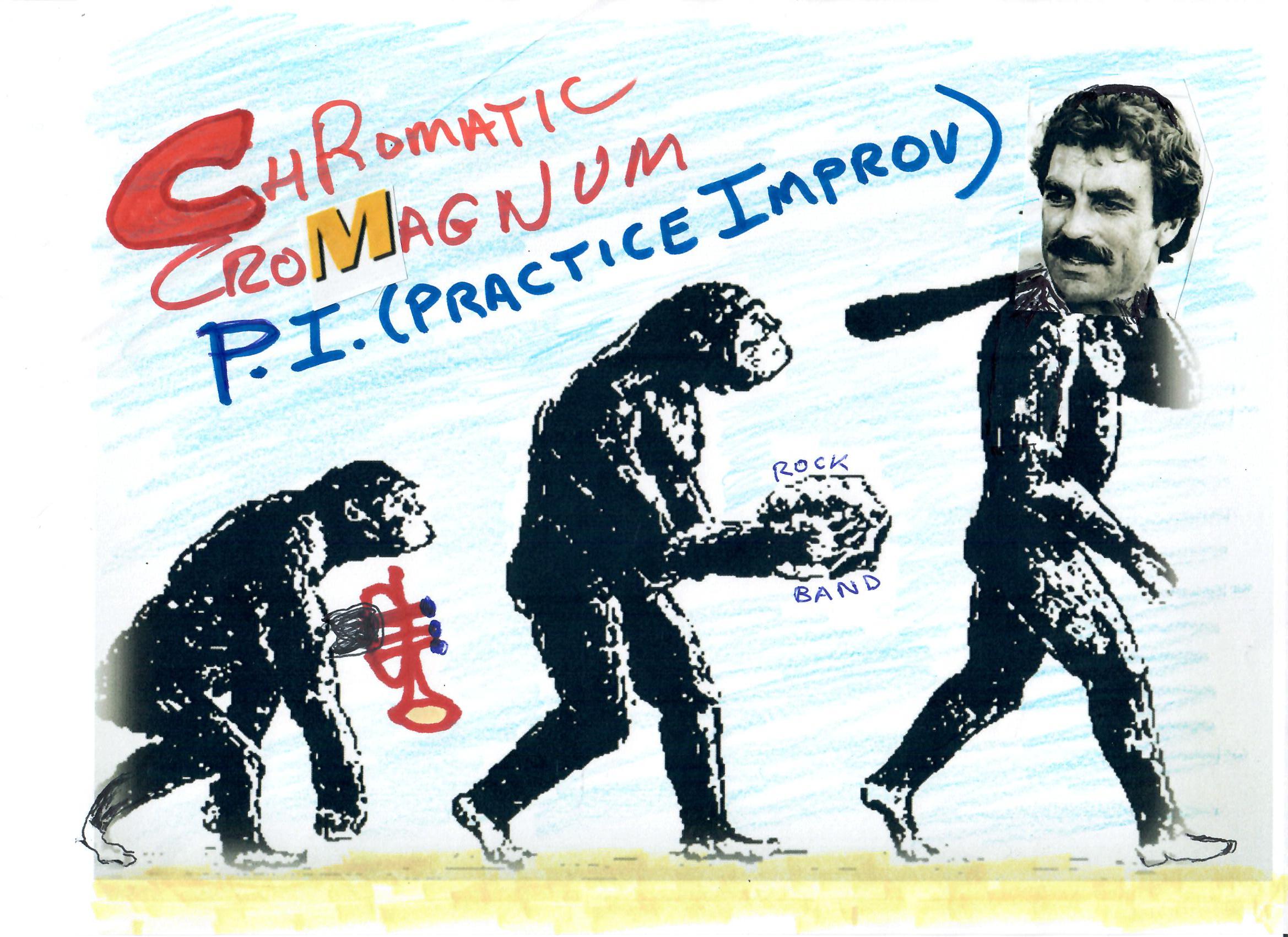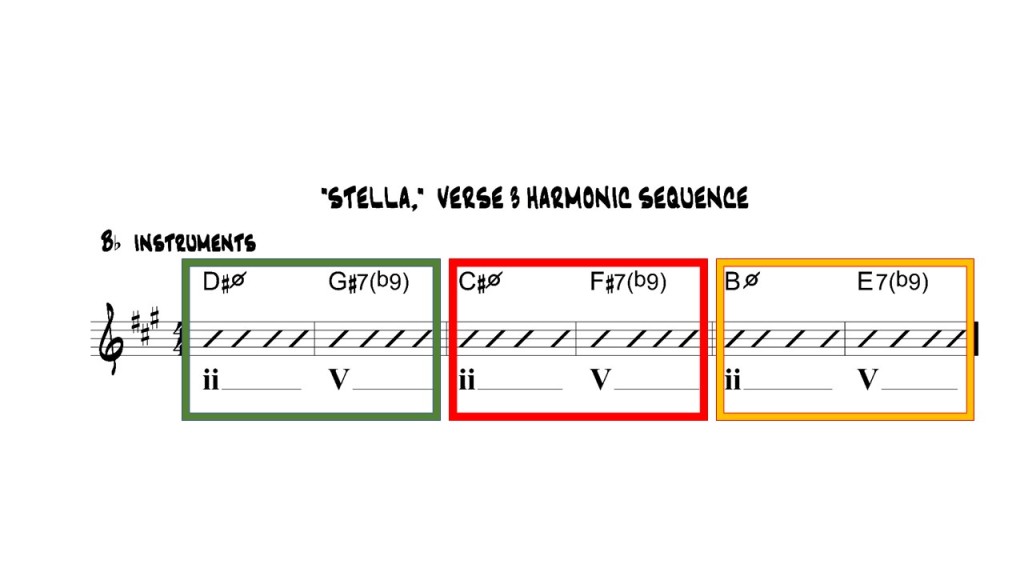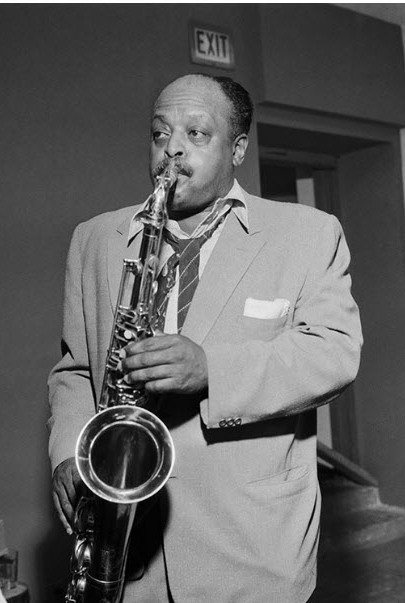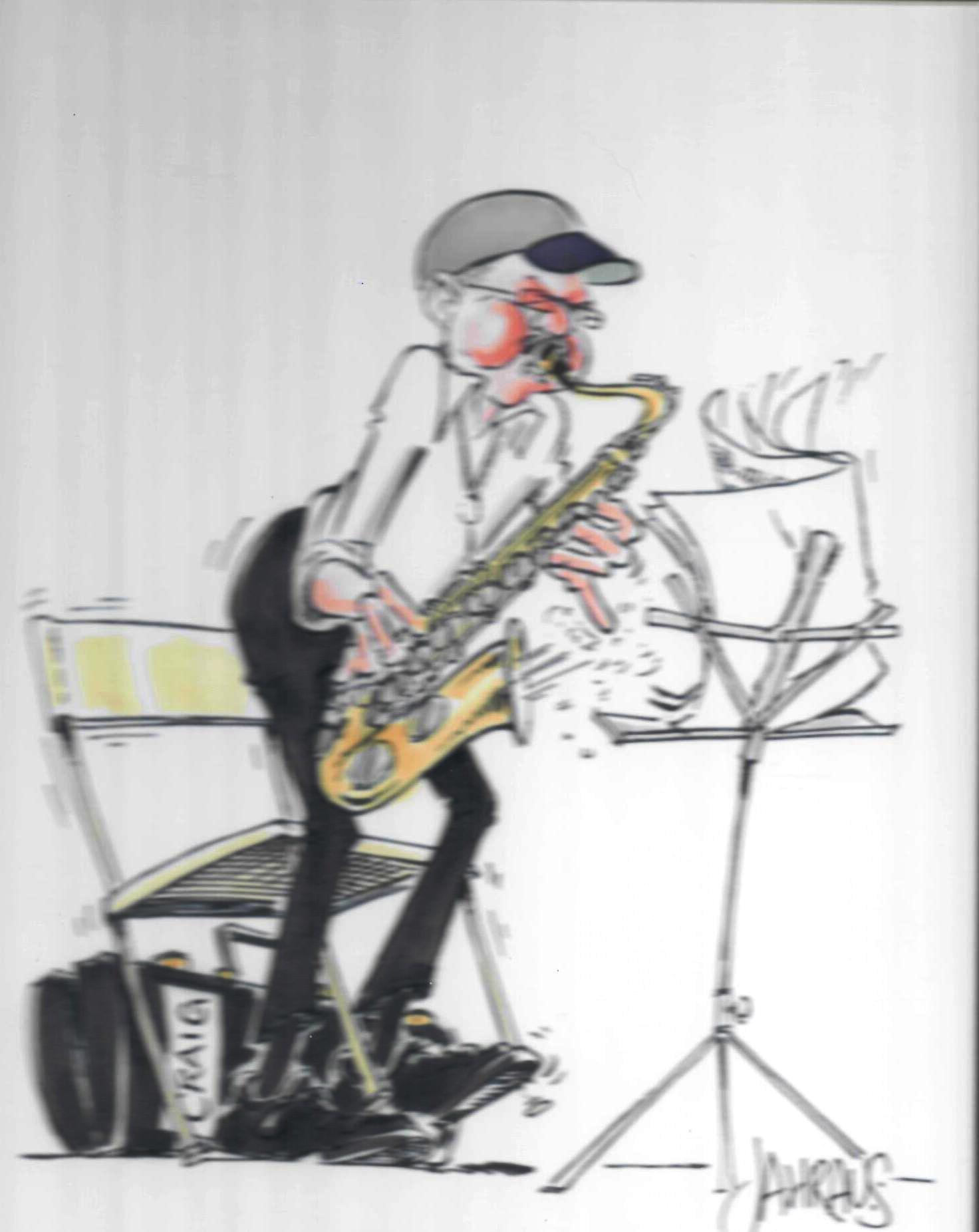Tenor saxophonist Brooklyn brought a favorite tune to his lesson. As always, we typed the changes into Band in a Box, chose a tempo and a groove, and started blowing on the tune. But Brooklyn said he was having trouble coming up with fresh ideas to play over the changes.
Category: Saxophone
Did the Key Change or What?
 The unpredictable flow of shifting key centers can easily throw uninitiated players off balance, especially when jamming on unfamiliar tunes. CLICK HERE TO WATCH THE VIDEO.
The unpredictable flow of shifting key centers can easily throw uninitiated players off balance, especially when jamming on unfamiliar tunes. CLICK HERE TO WATCH THE VIDEO.
Mixolydian ?? I’m Mixed Up !

This post defines the Mixolydian Mode and shows how you can use it in your music. Click here to watch the video.
Continue reading “Mixolydian ?? I’m Mixed Up !”
BLOW TILL YOU KNOW
Are you struggling to develop a personal improvisatory style or to find your unique compositional voice? Well, you’re not alone! Many musicians grapple with these dilemmas.
Perhaps my own story will help you unearth your path to musical originality.
I started playing because I love the way music sounds, the way playing the horn feels, the exhilaration of working with a great band of like-minded musicians. A couple years later, I began writing songs, just so we’d have originals for gigs and recordings. I didn’t think twice about trying to be original. On the contrary, emulating the masters was satisfying. It seemed to legitimize and validate my work.
However, about 10 years into my career, I suddenly faced an existential crisis, when nagging questions like these began keeping me awake at night:
“Is this composition any good? Is it too long? Which sections are valid and which need to be scrapped? Should that note be a Bb or an F#? Do my solos stink? What right do I even have to compose music or play the horn, when there are so many musicians out there who are way better?”
Chromatic Cro-Magnum P.I. (Practice Improv)
 Ever feel totally drained after a big gig with no steam left to practice, like a malnourished Cro-Magnon? That’s how I felt this morning, after last night’s intense concert backing up my friend presenting 14 of his complex original compositions.
Ever feel totally drained after a big gig with no steam left to practice, like a malnourished Cro-Magnon? That’s how I felt this morning, after last night’s intense concert backing up my friend presenting 14 of his complex original compositions.
What’s a person to do? Well, “one foot in front of the other,” as the old saying goes. Just start blowing long tones; dig the sound of the horn, experience the feeling of wind on reed, fingers on pearls.
Here’s what emerged after an hour or so; a little chromatic meander that caught my imagination. As harmonized in this sketch, it forms a Dorian setting reminiscent of “So What,” “Little Sunflower,” “Jeanine,” or “Invitation.” It could also have been harmonized as a ii-V progression in C major modulating to D minor.

Click on “continue reading” below to see a chart and hear the recording in all 12 keys.
Continue reading “Chromatic Cro-Magnum P.I. (Practice Improv)”
Cantabile

It comes from growing up with James Brown, Sly Stone, and Tower of Power:
I prefer punchy, funky, accented articulation and short, clipped, syncopated rhythms.
But comes a time when smooth, cantabile phrasing is on the menu. So here goes.

If you want to woodshed this lick in all 12 keys, click “continue reading” below to see a complete chart, hear the complete recording @ 180 beats per minute (BPM) as well as a slower complete recording @ 100 BPM.
Where’s One?
When a novice improviser strays too far from the beat, the band often quips, “Where’s One?”, meaning “Are you lost?”
As improvisers, we seek fresh, innovative approaches which still retain the coherence needed to keep listeners’ interest. Sonny Rollins famously used “motivic development” to simultaneously add unity and variety to his improvisations.
Here is a melodic phrase which is then repeated verbatim. What makes the second statement of this phrase sound different from the first?

Notice the “rhythmic offset”: the initial statement of the theme begins on beat 3 (we’re in 12/8), while the second statement begins on beat 12. Jazz players call this “playing on the other side of the beat.” If your band mates are sufficiently skilled to avoid getting lost, playing on the other side can be used to stunning effect.
Note also that the second statement of our melodic phrase – while melodically identical to the first – is accompanied by chords from a different key. We might refer to this as a “transposed harmonic setting.” The new harmonies give the melody a distinctly different sound, as if stage lighting on an actor had been changed from red to blue.
Practice Joy-Subconscious Symmetry
How’s your practice routine feeling lately? Are you practicing joy? If you practice joy, your audience will hear joy in your performance, and that lively winsomeness in your playing will win you way more fans than all the chops in the world.
Students ask what I mean by “practice joy.” Of course, it goes without saying that you need to develop your technique. But music is way more than just chops.
It may help to think of your practice session like a lavish banquet. …(we didn’t have many of those in 2020!) Think of it in 3 parts.
| Your banquet | Your practice session |
| 1. Introductions, greetings, catching up, small talk, hors d’oeuvres, drinks | 1. Your warm-up, settling in, loosening up, getting in the groove |
| 2. The main course | 2. Working intentionally through an idea or challenge |
| 3. Coffee, dessert, farewells, hugs or hand shakes | 3. Reward yourself with a fun little jam! |
Doesn’t that approach sound more doable, more inviting, more intriguing than staring forlornly at a closed horn case, wondering how to drum up energy to open that case and start playing boring scales?
Those 3 parts of your practice session remind me of Oliver Wendell Holmes’s comment about how a simplistic idea develops into a complex struggle but then resolves into a simple but elegant design.

So how about let’s design a practice routine so enthralling — so much fun — that you just can’t wait to pick up your axe and blow! As one typical example, here’s a practice session from a couple days back which was both productive and immensely enjoyable. Every day isn’t exactly like this. Sometimes the focus is on long tones, sometimes it’s reading through transcriptions, etc. But – on this particular late evening session – I followed Sonny Rollins’ advice. Sonny said, “just start playing the horn. Listen to the sound. Feel your breath and the keys of your axe. Play a blues. Play a tune. Play any old licks that come to mind.” Rollins called them “clichés,” but he didn’t mean that as an insult. They’re the bread and butter of learning. Don’t evaluate, don’t judge, just relate to your axe and enjoy how it sounds, how it makes you feel. After I blew for awhile, this lick just popped out.
I kind of liked it, so I kept repeating it. Maybe I tweaked it as I went along, I can’t remember. After getting it smooth in one key, I ran it down in all 12 keys. Then I wrote it down in my journal, knowing full well I’d forget it otherwise. After a day or two, I looked back at the transcription and discovered an inner logic — the thing that makes a phrase seem natural and organic – that I hadn’t noticed before. Up to that point, I’d just been blowing, without a sense of compositional coherence, or any of that theoretical stuff. But there it was, the musical logic, just waiting to be discovered…
Subconscious Symmetry
Below is a recording of me playing this phrase in all 12 keys along with a chart. After that, I discuss the logic hidden within this unusual phrase.
Blues in Benny Carter’s Heart
 Benny Carter blessed us with an amazing solo on the 1938 recording of his composition “Blues in My Heart.” The entire performance is miraculous, but one four-bar passage in particular knocked me out, prompting me to shed that phrase in all 12 keys. Here’s the lick:
Benny Carter blessed us with an amazing solo on the 1938 recording of his composition “Blues in My Heart.” The entire performance is miraculous, but one four-bar passage in particular knocked me out, prompting me to shed that phrase in all 12 keys. Here’s the lick:
Benny’s rhythmic vitality propels the piece, his melodic contour is unique in all of jazz literature, his harmonic inventiveness is preposterously original, and his crystal clear tone is infectious. Here is my transcription of those amazing four bars.

Here is a slowed down recording of that phrase in all 12 keys:
If you want to play it yourself, click the “continue reading” button to see a complete chart.
Stan’s Stella Sequence

Yesterday, I discovered a sequence in Stan Getz’s 1952 Clef recording of “Stella by Starlight,” (MGC 137). The three-by-three format unfolds as Stan finishes the bridge on his first chorus. Here it is:

If you’ve studied “Stella,” you know that the final 8 bar section of the form contains the intriguing 6-bar harmonic sequence shown below:

As shown here, that harmonic sequence features 3 iterations of 8 beats each, for a total of 24 beats. But Getz begins his amazing melodic sequence 2 beats before the passage shown above, so he needs to fill 26 beats.
The diagram below illustrates the incredible way he accomplishes this Herculean feat. Stan’s motif of six eighth-notes covers 3 beats and is repeated three times on each of three starting notes. But on the second iteration of round two, he leaves out a beat. Thus, the total episode comprises 9 + 8 + 9 = 26 beats. Even at 160 beats per minute, Getz is able to execute this monumental feat so smoothly that it sounds effortless.

Listen and Learn
If he’d survived, trumpeter Jack Sheldon would have turned 89 on November 30th, 2020. For one who never studied his recordings, it’s fascinating to watch a live video of his quintet in concert. The five musicians play in perfect sync, like a well-oiled machine, and they swing like crazy. Jack’s vocal style is instantly recognizable, and his trumpet sparkles with fiery assertiveness, crisp inventiveness, and unhesitating self-assurance.
The lick leading into the bridge of Jack’s solo especially knocks me out. Here it is:

There’s a dynamic shape to that melodic line and an infectious rhythmic vitality which combine to offer a wildly exciting listening experience. Equally impressive is Jack’s ability to infer fascinating harmonic curve-balls creating two deceptive modulations before settling onto the home key, as portrayed on the chart above .
Here’s that lick in all 12 keys.
A complete chart is provided below, if you want to woodshed this unique lick.
My friend Bill – an excellent trombonist – voiced his frustration after attempting the licks on my blog at full speed. I reassured Bill that I certainly do not begin by playing any of these licks at its ultimate pace. Here is the original tempo over which I started wood-shedding.
It took me several hours to get the lick up to tempo. With each new pass, you ratchet the metronome up maybe 3, 4, or 5 clicks until you reach your goal, and the most difficult note sequences require extensive looping in order to achieve smooth, effortless execution.
Here is Jack’s full solo:
As stated above, the band swings like mad throughout this entire performance. Here’s a link, if you want to listen to the whole cut.
Click on “continue reading” below to see a chart of the lick in all 12 keys.
Continue reading “Listen and Learn”Band Bus Banter
On the band bus one day, a buddy criticized me for playing too many descending lines. According to him, “Descending is negative; Ascending lines are much more uplifting.” Oh….really?
Players constantly hear advice like that.
Another commentator assured me, “Your phrase cannot EVER begin on the downbeat; It’s got to be asymmetric.” OK, you win, asymmetric it is, smart guy! The customer’s always right, ay?
One nameless critic insisted, “In order to sound hip, your line has to include several non-harmonic tones.” Still another self-proclaimed “authority” touted the need to stuff many rhythmic devices into your phrase.
Finally, a laconic trombonist named Tex snoring in the back of the bus roused himself from slumber just long enough to drawl lazily,
“How a – bout we try ta swing, Stan?”
So what do you think?
What is it that makes a player sound fresh and innovative?
While listening to the masters and practicing, lines like this one seem to pop out of nowhere. Hit ► below and let me know if it works for you.
Click on “continue reading” below to see a chart in all 12 keys. Or download “New Ears Resolution” to supercharge your ear, so you can play licks like this one in all 12 keys without a chart.
Continue reading “Band Bus Banter”Ben Webster’s “Mellow Tone”

For a chart in all 12 keys, click on “continue reading” below. Or – if you want to learn to play effortlessly without charts, download “New Ears Resolution.”
How Sonny Rollins Practices
How has the quarantine impacted your chops? This no-gigs lock down has been absolutely disastrous for many working musicians financially. But our chops don’t have to take the same hit our wallets are taking, if we’ll explore innovative approaches to practicing.
My practice strategy is similar to what Sonny Rollins described when asked how he practices. Sonny said:
“I start out playing things I know to get the blood flowing. Those things are often described as ‘clichés.’ You begin with the cliché so you can get the process in motion. Once the process is in motion, ‘thinking’ gives way to ‘playing.’ At that point, you get out of the way and let the music play.”
Over the past decade, I’ve written down over a thousand licks I keep in a notebook, each of which I woodshed in all 12 keys. Some of these ideas come from transcribed solos of the masters, but most simply emerge as I’m connecting with the horn. Practicing joy. I encourage you to try this technique, as it supercharges your chops, strengthens your improvisatory muscle, and turns you into a composer.
Here’s a lick you can play with, in order to get started down that path. The tonal center of this phrase baffled my friends and me at first. Eventually, I settled on a basic ii-V-I progression, which perfectly fit the melodic contour. If you want more background, leave a comment at the bottom of this post.
To see a chart, click on “CONTINUE READING” below.
Half-Diminished? Minor 7, Flat 5? Aaargh !!
Click the link below to read the script of this video.
Continue reading “Half-Diminished? Minor 7, Flat 5? Aaargh !!”
Discovering Your Personal Jazz Improvisational Style
Click on “continue reading” below to see the text of this video.
Continue reading “Discovering Your Personal Jazz Improvisational Style”
Peaceful Assurance, Permanent Security.
Need a peaceful respite from the current chaos? Click Here.
How to Create, Name, and Use Chords to Evoke Emotion and Make Music Come to Life!
 In just 45 minutes, you can revolutionize your understanding of THE HARMONIC LANGUAGE. Learn how chords are created, what notes they contain, how they’re named, and how they’re used to evoke emotion and make music come to life. Quickly gain harmonic mastery and confidence which will set you apart as a composer or improviser.
In just 45 minutes, you can revolutionize your understanding of THE HARMONIC LANGUAGE. Learn how chords are created, what notes they contain, how they’re named, and how they’re used to evoke emotion and make music come to life. Quickly gain harmonic mastery and confidence which will set you apart as a composer or improviser.
Click here to watch this fascinating video on YouTube for free.
Pres says, “Sing me a song!”

Let’s face it, we all want monster chops. There are some great books out there to help develop technique. I work constantly on mastering lix in all 12 keys, but I never play those lix on the gig. That’s not their purpose. The reason for practicing lix is to enhance your facility on the horn and expand your musical vocabulary.
But some of those lix get so obscure, I can’t even tell if I’ve made a mistake in transposing the lick to a new key. That’s when I know the lick is too obscure!
I just got a killer deal on a great classic clarinet mouthpiece. That inspired me to do some long overdue clarinet shedding. I was trying to come up with a lick that felt melodic, one that would swing and sound lyrical, as opposed to clinical.
Let me know what you think of this one.
To see the chart for this lick in all 12 keys, press the “Continue Reading” button.
Stan Getz Solo From “O Grande Amor”
 Looking for a refreshingly novel approach to playing over a minor ii-V-i ? Here’s an idea by Stan Getz. It’s from bars 15 & 16 in the first chorus of his solo over “O Grande Amor” from “The Stockholm Concert.”
Looking for a refreshingly novel approach to playing over a minor ii-V-i ? Here’s an idea by Stan Getz. It’s from bars 15 & 16 in the first chorus of his solo over “O Grande Amor” from “The Stockholm Concert.”
B flat instruments start at line 1. Concert key instruments start at line 3, and E flat instruments start at line 12. (Double back to the beginning when you reach the end of the chart.)


Stan Getz: A Brief History, An Appreciation
The vast recorded legacy of legendary tenor saxophonist Stan Getz still astounds the jazz community. Here it is in words and music. From his earliest days with Jack Teagarden, Stan Kenton, Benny Goodman, and Woody Herman to the phenomenal smash hits “Desafinado” and “The Girl From Ipanema” (which sparked the 1960’s bossa nova craze), to his sublime later work with pianist Kenny Barron, Stan Getz continued to galvanize the musical world with his unparalleled technique, unmistakably unique sound, and gorgeous lyricism. Take a tour with us of this amazing 40-year jazz odyssey.
Click on this link to see and hear more: https://youtu.be/pIDS5x7leYI

The Chord Committee
Many, many thanks to everyone who volunteered for The Chord Committee. Numerous excellent solutions have been proposed. In order to avoid discord, I have combined all of your suggestions into one beautiful, majestic chord. In hopes you will find the solution acceptable, the chart and recording are presented here for your approval. (Click on “continue reading” to view the complete chart.)
The Lost Chord
Andy and i were playing this lick the other day.

Andy asked with which chord this lick could be used. I had no answer. Do you?
Got Improv?
You can learn how to improvise like a professional jazz musician! Watch this video to see how you can begin the exciting journey towards becoming a jazz improviser.
Fats Waller & Arpeggios
 Mastering arpeggios gives you yet another tool to use (in moderation) in your improv solos.
Mastering arpeggios gives you yet another tool to use (in moderation) in your improv solos.
Have you ever tried playing Fats Waller’s great tune “The Jitterbug Waltz”? Find it on Rahsaan Roland Kirk’s “Bright Moments” album. Mastering arpeggios will make that tune much easier to play.
Here’s a challenging and interesting way to master arpeggios. The idea for this exercise was suggested to me by a warm-up my talented friend Al Thompson often uses.
Click on “continue reading” for a complete chart.
Bonfa, Jobim, and Bossa Nova
 Brazilian bossa nova’s introduction to the U.S. thanks to composers Luiz Bonfá (Samba de Orfeu and Manhã de Carnaval), Antônio Carlos Jobim (Desafinado, Girl from Ipanema, Corcovado, etc.), and instrumentalists João Gilberto and Stan Getz literally transformed the jazz landscape overnight.
Brazilian bossa nova’s introduction to the U.S. thanks to composers Luiz Bonfá (Samba de Orfeu and Manhã de Carnaval), Antônio Carlos Jobim (Desafinado, Girl from Ipanema, Corcovado, etc.), and instrumentalists João Gilberto and Stan Getz literally transformed the jazz landscape overnight.
For the past 50 years, casual straight-ahead jazz gigs have invariably featured at least one bossa per set.
Familiarity with the following exercise will greatly enhance your facility with the melodic and harmonic nuances found in these wonderful compositions. Here is the basic lick:

Here is a recording of the lick played in all 12 keys:
Develop your ear to flawlessly play passages such as this one in all 12 keys by downloading and working through “New Ears Resolution.”
TEST YOUR EAR!
You’ll ace this one, if you’ve played through “New Ears Resolution.” If not, it may be tricky.

Below is a recording of the pattern in all 12 keys. Submit a “comment” at the bottom of this post, if you need a chart to play along with the recording.
Note that this phrase traverses the first five chords of the standard “Someday My Prince Will Come,” a long-time staple of Miles Davis’s book. That “harmonic quote” was not intentional. When you start creating patterns in a “stream of consciousness” manner, elements of your repertoire tend to crop up in various guises.
Multi-instrumentalist Kevin McCartney recently taught me about the ebb and flow of tension and release created by Cuban clave patterns. In this exercise, the many accidentals create a bit of harmonic tension, which is then released through resolution to adjacent diatonic notes. Note in particular the tension created by Si, Di, and Le.
Upon further reflection today (during surgical anesthesia!), it occurred to me that this phrase uses all 17 notes in the scale: the 7 diatonic pitches, the 5 sharps, and the 5 flats. For a horn player, G# and Ab are identical. However, a symphonic violinist thinks of them quite differently.
What you hear in this recording is actually 5 clarinets. Took me about 20 takes to get 5 usable ones.
Dig Jimmy Heath!
 Jimmy Heath is another master with whom I hope to become more familiar.
Jimmy Heath is another master with whom I hope to become more familiar.
Driving into a glorious autumn dawn on the way to church Sunday, I was listening to “Picture of Heath” and was particularly struck by the third chorus of Jimmy’s soprano solo on “All Members.”
I don’t usually go to the trouble of formally transcribing solos, since there are so many fine transcriptions available on-line. But Jimmy’s third chorus really knocked me out, and i felt compelled to examine the strategy, structure, and logic of this amazing 12-bar chorus. Continue reading “Dig Jimmy Heath!”
Mastering Modulation
Have you ever ridden on a roller coaster blindfolded? That’s how it feels to improvise without understanding internal modulation. It’s like driving through a thick London fog. Progress is halting, movements are uncertain and tense.
By contrast, the player who understands how to navigate key changes improvises smoothly and confidently.
This month, we learn to recognize an internal modulation and craft an effective response. Continue reading “Mastering Modulation”
Developing Hand – Ear Coordination

Do you want your improvised solos to soar and delight your audiences? The first and most important step to achieve this is to develop the link between your ears and your fingers. In fact, ultimately we need to be able to transfer any musical idea we imagine to our fingers. I call this “Hand-ear coordination”.






